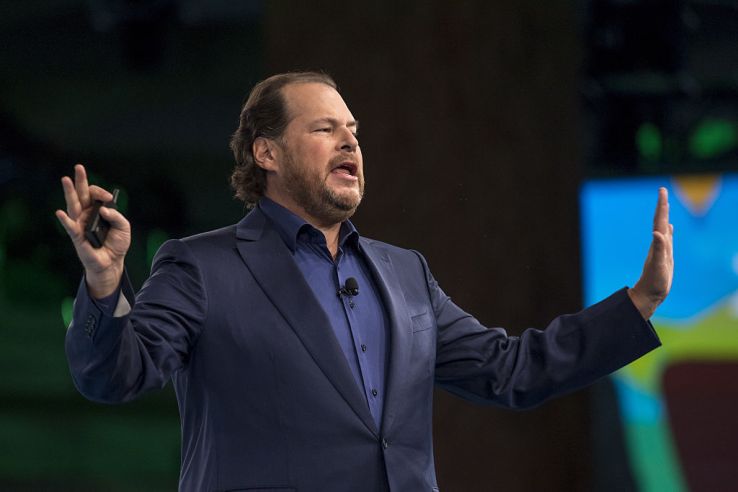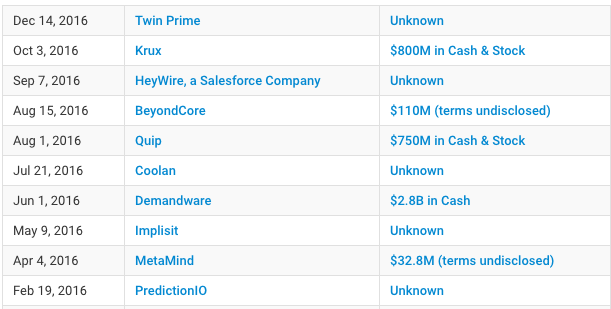But this year as the cloud mainstreamed and Salesforce took off on a $10 billion run rate, you couldn’t help but feel that after 17 years in business, that Salesforce’s time had finally come. As their lofty revenue goals suggest, they have no intention of stopping any time soon. On a buying binge Salesforce opened up its wallet this year, buying 10 companies, spending at least $5 billion, based on the deals with release prices. That’s up from five deals last year, after just one in 2014. Is it good product fit? While we didn’t know it, the company had been working on building an artificial intelligence platform, which it announced in September (more on that later). Salesforce turned that acquisition into Commerce Cloud in late September, filling in a big hole in its platform. This year, he also hired Tony Prophet to be the company’s Chief Equality Officer, an unprecedented step in tech industry, an industry that has been highly criticized for its lack of diversity. The goal with AI is to help surface information and proactively help the sales team, turning CRM (and other parts of the Salesforce platform) into a tool that can assist and suggest in a much more prescriptive way. It’s a compelling property for a company like Salesforce because the data has the potential to be incredibly valuable.

Salesforce has always liked to think of itself as an industry irritant, the company that was bucking the status quo and making the established players feel uncomfortable. But this year as the cloud mainstreamed and Salesforce took off on a $10 billion run rate, you couldn’t help but feel that after 17 years in business, that Salesforce’s time had finally come.
The company went on a historic acquisition shopping spree, hitting some targets and missing others — and at one point seeing its target wish list leaked to the public in the Wall Street Journal. It also stayed firmly on the technology cutting edge by joining the parade of companies building artificial intelligence into their products.
While it went on quite a run this year, it still stayed true to its community service roots. After threatening to pull out of Indiana in 2015 over anti-LGBTQ legislation, it did the same in Georgia and North Carolina in 2016. CEO Marc Benioff remained a passionate spokesperson for responsible capitalism and hired Tony Prophet at as the company’s first Chief Equality Officer.
While not everything went its way, all in all, not a bad 12 months. Let’s take a closer look.
Show me the money
It all starts with being a focused company, and few could argue that Salesforce doesn’t execute. In November, the company delivered a strong Q3 2017, after showing some signs of weakness in Q2. What’s more, revenue continued to trend up. CEO Marc Benioff predicted the company would reach its $10 billion run rate goal some time in 2018, and went so far as to forecast the company would reach $20 billion “faster than any other company,” (although he didn’t give a timeline for that goal).
According to data from the PwC Global 100 Software report (pdf), which ranked the world’s software companies based on fiscal 2014 revenue numbers, Salesforce was was one of the top 10 software companies, coming in at number 9. As their lofty revenue goals suggest, they have no intention of stopping any time soon. The thing is, Salesforce is bursting through these revenue milestones as a SaaS vendor, proving that SaaS vendors can be highly successful organizations.
On a buying binge
Salesforce opened up its wallet this year, buying 10 companies, spending at least $5 billion, based on the deals with release prices. That’s up from five deals last year, after just one in 2014. It’s worth noting that two of those 2015 acquisitions came in December, perhaps foretelling the buying binge that was to come.

All good acquisitions bring some combination of engineering talent, filling a functionality gap and driving revenue (obviously a big goal for any company, but especially Salesforce). As Salesforce president, vice chairman and COO, Keith Block explained in September they look at a number of factors when they buy a company:
“We look at culture. Will it be a good cultural fit? Is it good product fit? Is there talent? Is there financial value? What are the risks of assimilating the company into our company,” Block explained.
In April, it made an important purchase related to artificial intelligence when it bought MetaMind for a relatively modest $32.8 million. With it, they acquired the talents and expertise of CEO Richard Socher, who immediately became Salesforce’s Chief Scientist, contributing his deep learning and natural language processing knowledge. While we didn’t know it, the company had been working on building an artificial intelligence platform, which it announced in September (more on that later).
The biggest fish by far was Demandware, for which Salesforce paid $2.8 billion in June, the highest amount it ever paid for a company. Salesforce turned that acquisition into Commerce Cloud in late September, filling in a big hole in its platform.
Perhaps the most unusual of its 10 acquisitions was word processing platform, Quip, for which it laid…
COMMENTS